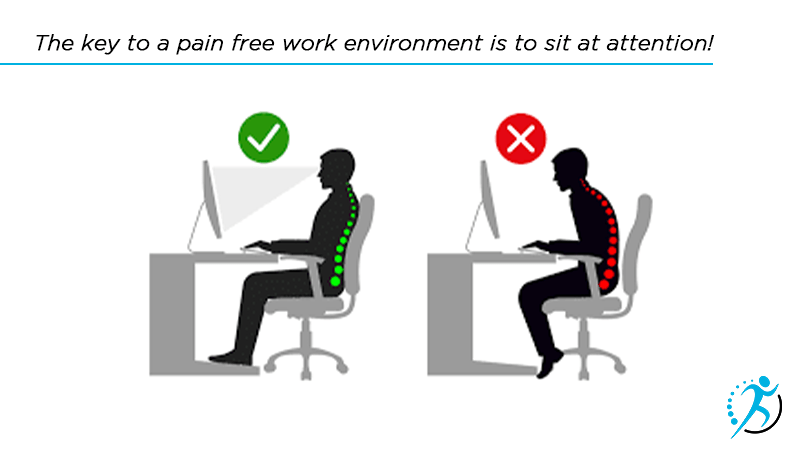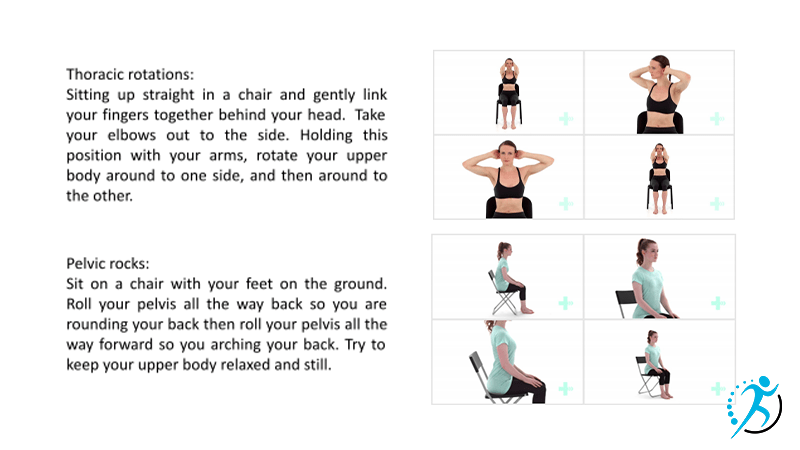
Ten things you can do at work home to help with your neck, shoulder and back pain
The reality is that the pandemic has most likely changed how we work and where we work forever.
Your workstation is fundamental to your productivity at the office and at home. It is important that you have it set up properly so you can focus on your work and not your aches and pains.
What is ergonomics?
Ergonomics is about “fitting work to people”. It is the process of designing or arranging workplaces, products and systems so they fit the people who use them.
In the effort to decrease physical and emotional stress, humans have done tasks in different ways. To make work easier and more efficient, shovels were made lighter, cockpit controls were made more logical and machines were made to be driven by electricity.
Ergonomics in the workplace
Because of the pandemic it is probably more accurate to say ergonomics in the homeplace.
When we discuss ergonomics in the workplace, we commonly refer to posture and sitting in front of the computer as that is where the majority of an office worker’s time is spent.
Statistics show that on average an office worker spends 95% of their day sitting in front of the computer
Workplace ergonomics attempts to reduce strain, fatigue and injuries by improving product design and workspace arrangements, such as properly positioning your chair, keyboard and monitor.
Good ergonomics
Equipment
- Chair: with levers, handles, wheels and low back support
- Multiple monitors
- Ergonomic mouse and keyboard
- Sit to stand desk

Posture
We have all seen the image below indicating the key to a pain free work environment is to sit at attention! In fact I used to educate my patients on this erect perfect posture.

But the reality is the research that correlates posture to low back pain is weak.3,4 There is no perfect posture!
I treat many office workers who have low back and neck pain. I hear patients saying multiple times a day; “if I had better posture my pain would be better”. In all fairness, if you Google office ergonomics you will be flooded with information telling you to sit up straight. Make sure you have your elbows and hips at a perfect 90 degrees! Sounds more like you are set for battle and not a relaxed work day.
No matter how you sit, even if you use the best chair, if you don’t move for 2, 3 or 11 hours you will eventually experience some stiffness and discomfort.
Evidence suggests that changing postures often helps reduce joint and muscle aches that individuals may experience with prolonged desk work.

How many hours do you spend sitting per day?
The reality of social distancing and working from home means less opportunity to move. Commuting has become a few steps from the bedroom to the home office. Walking to a meeting has become a push of a zoom button. Taking a coffee break at your favourite barista has become a saunter to your kitchen.
According to reporting, Canadians are working two hours longer at home than they were in the office as they navigate self-isolation during COVID-19.
Canadians who used to put in nine hour work days are now working 11 hours
Calculate the number of hours you sit on an average work day
Make sure to then add in the number of hours you are sitting watching Netflix, pouring over puzzles, playing video games, having zoom parties with friends and scrolling on your device.
On average, adults spent 9 hours and 48 minutes of their waking time being sedentary
Canadian adults report that they accumulate 23.6 hours of screen-time each week during leisure time. That is over 3 hours per day!
The research is clear and we have known for a very long time that a lack of exercise, being a couch potato, not moving often; no matter how you say it, being sedentary is not good for you.
Ergonomics at home
With the realization that working from a home office is here to stay, we need to stop working at the dining room table or island in the kitchen as it is leading to increased neck, back and shoulder pain.
Ten things you can do at home to help with your neck, should and back pain
- Move: any posture that is uninterrupted can become painful.
- Twist, bend, slump, maneuver and squirm
- Stand: take a break from your computer every 30 minutes, stand during meetings.
- Go for a walk: take regular walks (yes regular, as in every hour) around your house, the block and up and down the stairs.
- Stretch: add a stretch reminder to your computer, watch or phone. For instance, stretch every 45 minutes.

- Go outside: get up and out of your house for lunchtime and go for a 10-minute brisk walk. Research shows that being in nature, even for a short duration, helps to reduce stress.
- Drink water: you will need to fill you water glass and visit the bathroom more regularly
- Consider having 2 work stations: get a standing desk so you can alternate between standing and sitting to change up your positions.
- Practice deep breathing for stress relief: Breathe in through your nose allowing your rib cage to expand and out through your mouth – take 10 deep breaths 3 times a day. This is beneficial for improving oxygen levels in your muscles as well as for stress relief.
- Exercise : Exercise is the closest thing to a miracle cure
The Canadian Physical Activity and Sedentary Guidelines were released in 2011 by the Canadian Society of Exercise Physiology and recommends: 150 minutes of moderate to vigorous exercise per week (Moderate-intensity includes activities like brisk walking or bike riding that cause adults to sweat a little) That’s 22 minutes of walking per day. It can be done in 10 minute increments
- Still in pain? Contact a Physiotherapist
How a Physiotherapist Can Help

Physiotherapists can now see your work space virtually. With the evolution of online sessions, we have the advantage of seeing you at home in your new work environment.
Physiotherapy online ergonomics assessment:
- Posture assessment
- Home station set up evaluation
- Desk and chair height
- Mouse and keyboard placement
- Monitor positioning
- Equipment recommendations
- Advice and strategies to address areas of your body that are stiff and sore
- Design an exercise program to strengthen your core postural muscles
- Strategies to increase your activity throughout the day
Need help with aches and pains from sitting too much? Email Avenue Physio at info@fifthavephysio.com for some immediate advice and relief.
FAQ
Start with a comfortable space with good lighting. Proper ergonomics includes correct chair, table and monitor height.
Good ergonomic solutions can make you more comfortable, increase productivity and ward off musculoskeletal aches and pains.
Schedule “movement breaks” every hour.
Have a timer that goes off to ensure that you get up and walk away from your workstation. Movement breaks can be as simple as walking up and down the stairs, walking around the block or just standing for your next zoom meeting.

Written by Kelly Barrie
Kelly is the owner of Avenue Physio and proud to be part of a supportive and personable team that is dedicated to providing a high quality of treatment and experience to patients. She has been a physiotherapist for over 25 years treating a range of orthopedic conditions including chronic pain, motor vehicle collisions and sport injuries (from weekend warrior to high level). Kelly has always been passionate about movement and promoting healthy lifestyles. First, as a Certified Personal Trainer, and for the last 25 years as a physiotherapist. Kelly has completed the highest level of Certification in Manual and Manipulative Therapy that is internationally recognized (FCAMPT). Advanced knowledge of strengthening programs, manual therapy skills and critical thinking optimize her treatment plans for her patients so they can reach their movement goals.
References:
- Occupational Safety and Health Administration (OSHA) Statistics
- Deyo RA. Magnetic Resonance imaging of the lumbar spine. Terrific test or tar baby? NEJM 1994:331(2):115-116
- Grundy, Roberts (1984) Lancet. 1984 Aug 4;2(8397):256-8.
- Pope, Bevins (1985) Spine (Phila Pa 1976). 1985 Sep;10(7):644-8.
- Hartvigsen J et al. Scand J Public Health 2000; 28: 230-239.
- Kwon. MA, J Korean Med Sci. 2006 Dec;21(6):1086-91.

